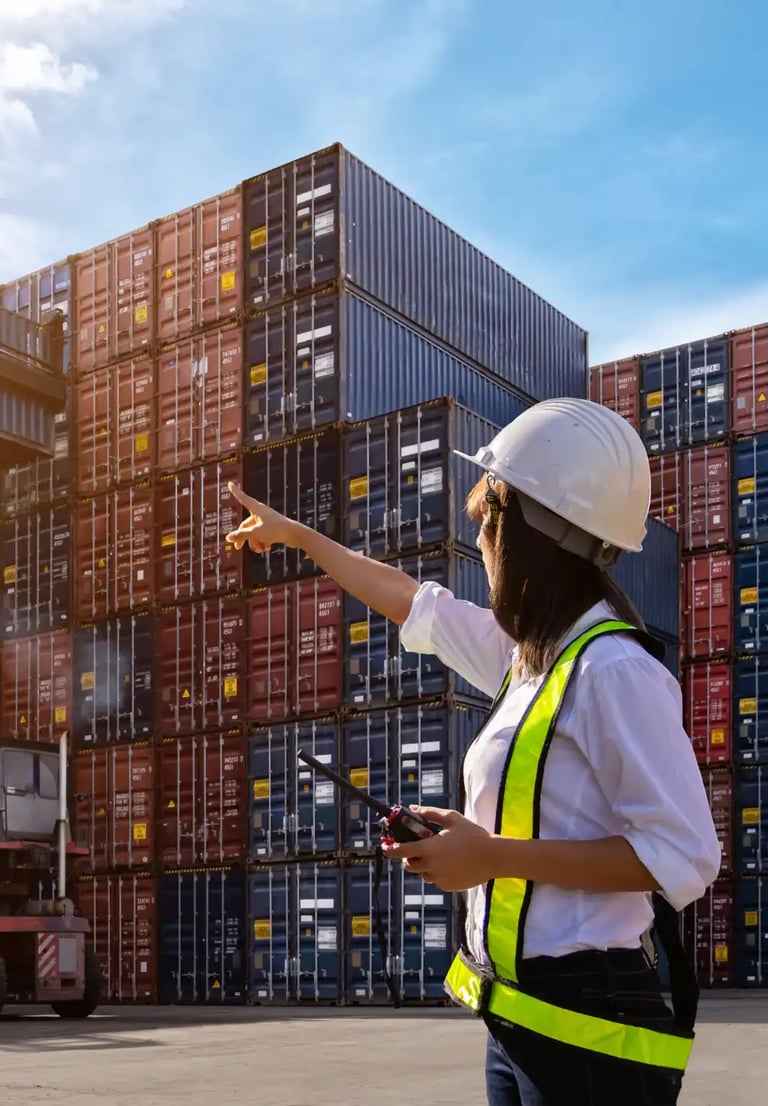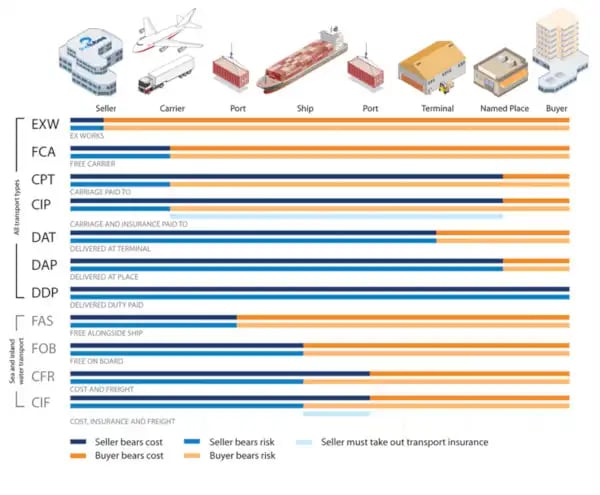SOLAR PANEL IMPORT PROCEDURES
In this article, we will briefly cover the steps of finding suppliers, requesting quotes, and negotiating for solar power systems. The focus will be on some key considerations when you proceed to sign international trade contracts
VIETNGA ENERGY
3/2/20245 min read
PART 1: IMPORTANT NOTES ON INTERNATIONAL TRADE CONTRACTS FOR SOLAR PANEL IMPORTATION
-----1.1. Detailed information about the solar power system you plan to purchase
-----1.2. Delivery terms under Incoterms for solar panel imports
-----1.3. Commonly used Incoterms in international trade contracts:
----------1.3.1. Ex Works (EXW)
----------1.3.2. Free on Board (FOB)
----------1.3.3. Cost and Freight (C&F, CNF, CFR)
----------1.3.4. Cost, Insurance, and Freight (CIF)
-----1.4. International payment terms for solar panel imports
----------1.4.1. Telegraphic Transfer (T/T)
----------1.4.2. Letter of Credit (L/C)
PART 2: RECEIVING THE DOCUMENTS FOR THE SHIPMENT
-----2.1. Required documentation for importing a solar power system:
-----2.2. Verification of the document set
PART 3: COMPLETING THE IMPORT PROCEDURES FOR SOLAR POWER SYSTEMS
-----3.1. Receiving the cargo arrival notice from the shipping line:
-----3.2. Filing and transmitting the electronic customs declaration
-----3.3. Obtaining the Delivery Order (D/O)
----------3.3.1. Required documents and fees for obtaining the D/O:
-----3.4. Completing customs clearance for solar panel imports
-----3.5. Transporting goods from the port to the warehouse


PART 1: IMPORTANT NOTES ON INTERNATIONAL TRADE CONTRACTS FOR SOLAR PANEL IMPORTATION
In this article, we will briefly cover the steps of finding suppliers, requesting quotes, and negotiating for solar power systems. The focus will be on some key considerations when signing international trade contracts.
When negotiating contracts with foreign suppliers, customers should pay close attention to the following clauses:


1.1. Detailed information about the solar power system you plan to purchase
Product description: product name, model, and code
Country of origin
Catalogue and technical specifications
Functional suitability
Warranty conditions
Certificate of Quality (C/Q)
Product Test Report
Certificate of Origin (C/O).
1.2. Delivery terms under Incoterms for solar panel imports
Incoterms are a set of rules defining the responsibilities and costs borne by parties involved in international trade. They are widely recognized and used worldwide and are typically revised every 10 years to adapt to business trends. The latest set of 11 Incoterms is categorized into four groups: E, C, F, and D.
1.3. Commonly used Incoterms in international trade contracts:
1.3.1. Ex Works (EXW)
The exporter (seller) delivers goods at the seller’s premises.
The seller fulfills their delivery obligation by making the goods available to the buyer at the seller’s facility or a designated location (factory, warehouse, etc.) in the exporting country. The seller does not bear loading costs unless stipulated in the contract. The buyer must pay for main transportation costs, domestic transportation costs, and customs clearance at both export and import ends.
When using this term, buyers should negotiate for the seller to assist with loading the goods onto the transport vehicle at the seller’s premises.
1.3.2. Free on board (FOB)
The seller is responsible for delivering goods to the export port and covering related costs until the goods are ready to be loaded onto the international transport vehicle.
The buyer has the right to select the international carrier and transportation schedule, with these costs borne by the buyer.
1.3.3. Cost and freight (C&F, CNF, CFR)
The seller is responsible for delivering goods to the import port. Therefore, the seller selects the international carrier. Buyers should clarify the international carrier with the seller to check costs associated with the import port, as these fees vary among carriers and are typically non-negotiable for the buyer. Additionally, the shipping schedule is determined by the seller, so buyers should carefully review the timeline and transit duration.
1.3.4. Cost, insurance and freight (CIF)
Similar to CNF but with the seller also purchasing cargo insurance.
1.4. Điều khoản thanh toán quốc tế khi nhập khẩu pin năng lượng mặt trời
There are two basic and widely used payment methods in international trade contracts:
1.4.1. Telegraphic Transfer (T/T)
T/T is a relatively simple payment method in which the importer authorizes their bank to debit a specified amount from their account and transfer it to the exporter at a designated time and location.
1.4.2. Letter of Credit L/C
The bank issues an L/C at the buyer’s request, committing to pay the seller a specific amount within a certain timeframe, provided the seller submits valid and compliant documents per the L/C terms. This method is commonly used when the two parties are transacting for the first time or when trust levels are not yet established.
PART 2: RECEIVING THE DOCUMENTS FOR THE SHIPMENT
After the goods are loaded onto the ship, the seller will send the buyer the necessary documents to complete customs clearance for the shipment at the import port
2.1. Required documentation for importing a solar power system:
Commercial Contract
Commercial Invoice
Packing List
Bill of Lading
Certificate of Origin (C/O), using Form E if the goods originate from China (if applicable)
Catalogue
2.2. Verification of the document set
Receive and verify the information on documents such as the bill of lading, commercial invoice, packing list, contract, and C/O to ensure consistency. It is essential to thoroughly check these documents to avoid errors that could complicate the customs clearance process.
Based on the information in the document set and the product catalogue, determine the HS code. The HS code may vary depending on the structure and technical specifications of the goods.
PART 3: COMPLETING THE IMPORT PROCEDURES FOR SOLAR POWER SYSTEMS.
3.1. Receiving the cargo arrival notice from the shipping line:
Typically, 1–2 days before the shipment arrives, the carrier or agent will send an arrival note. This note usually includes:
Name, address, and phone number of the issuing party.
Indication of whether the original bill of lading needs to be presented.
Details of surcharges to be paid, such as documentation fees, CIC fees, EBS fees, etc. (some carriers may not specify these fees).
3.2. Filing and transmitting the electronic customs declaration
Import procedures for solar panels
Assign the customs declaration category for the shipment.
Prepare the electronic customs declaration. Besides the necessary document set, the importing business must have a digital signature to transmit the declaration.
After submitting the official declaration, the customs system will automatically assign a clearance lane:
Green Lane: Only requires tax and VAT payment, customs procedures, and goods receipt.
Yellow Lane: In addition to Green Lane tasks, paper documentation must be presented for customs review.
Red Lane: Requires tax and VAT payment, submission of documentation for customs review, physical inspection of goods, customs clearance, and goods receipt..
For businesses handling imports for the first time, there is a 90% likelihood of receiving a Red Lane classification.
3.3. Obtaining the Delivery Order (D/O)
A delivery order is issued by the shipping company (carrier or forwarder) to instruct the storage unit (port or warehouse) to release goods to the owner. The delivery order is a critical document required for customs procedures, sample inspections, and goods collection.
3.3.1 Required documents and fees for obtaining the delivery order:
Photocopy of ID card
Original bill of lading
Photocopy of the arrival note
Authorization letter
Fees: These are typically listed in the arrival note to help the consignee prepare in advance. For container shipments, additional fees may apply, such as container deposit fees and storage fees for containers exceeding the allowed storage duration.
3.4. Completing customs clearance for solar panel imports
Onsite personnel submit the customs declaration to the customs office where the importing business is registered. Depending on the assigned clearance lane, the customs procedures will vary.
3.5. Transporting goods from the port to the warehouse
After clearing customs, onsite personnel register the vehicle, complete gate clearance, and transport the goods to the warehouse to complete the shipment process.
VIETNGA ENERGY
Savings - Efficiency - Sustainability
Xem thêm các tin tức liên quan khác
HEAD OFFICE
Address | No. 3, Street 10, Quarter 4, An Khanh Ward, Thu Duc City, Ho Chi Minh City, Vietnam.
Phone | (+84) 286 2872 067
Email | info@nangluongvietnga.com
REPRESENTATIVE OFFICE
Address | Floor 5, IC Building, No. 82 Duy Tan Street, Dich Vong Hau Ward, Cau Giay District, Hanoi, Vietnam.
VIET NGA SUSTAINABLE ENERGY CO., LTD
BUSINESS SUPPORT
Phone | (+84) 937 669 985
Email | hoangsen@nangluongvietnga.com
Phone | (+84) 964 819 199
Email | thuynv@nangluongvietnga.com
TECHNICAL SUPPORT
Phone | (+84) 902 968 481
Email | chinhnv@nangluongvietnga.com
Phone | (+84)96 481 9199
Email | thuynv@nangluongvietnga.com
------------------------------------------------------------------------
CONFIDENTIAL & PROPRIETARY
Copyright by VIETNGA ENERGY | 2024 All Rights Reserved Design by Cre-tive Network


